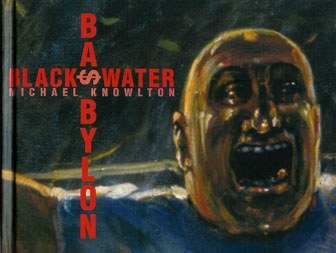
CAUSTIC
REDRESS
The rising tide of visual essayist Michael Knowlton
Blackwater Babylon exhibition book / Intro essay
CSUF Grand Central Art Center / Grand Central Press
By Nathan Spoor
" A true war story is never moral. It does not instruct, nor encourage virtue,
nor suggest models of proper behavior, nor restrain men from doing the
things men have always done. If a story seems moral, do not believe it. If at
the
end of a war story, you feel uplifted or if you feel some small bit of
rectitude from the larger waste, then you have been made the victim of a very
old and
terrible lie. There is no rectitude whatsoever. There is no virtue. As
a rule of thumb, therefore, you can tell a true war story by its absolute and
uncompromising
allegiance to obscenity and evil."
- Tim O'Brien
" I believe in compulsory cannibalism. If people were forced to eat what
they killed there would be no more war."
- Abbie Hoffman
It is a time where current artistic trends would have one believing that
the post-nuclear world is in a state of pluralist fluff worship. It is
also a day
and age where consumerist propaganda is the mass drug of choice, leaving
entire demographics of the Americas in a vacant wake of better cleansers
and the inevitable
boredom of political white-washings. But it is also the moment when a critical
eye, a tried and true heart and an expressive hand can capture a moment
in as trusting a hold as any vexed tongue. Political realist and satirist
Michael
Knowlton captures the essence of this contemporary landscape.
In 1965 ,the budding sociopolitical visual spokesman, was fifteen years
old. His father, then a Colonel in the Air Force Reserves, was called upon
to travel
to the yet-unknown staging grounds of the conflict in Vietnam. His experience
in country provoked a profound change in his outlook which provoked many
family dinner discussions. At this point, the conflict had still to escalate
fully,
catching the media and culture's eye. But when it did, it would leave a
lasting impression upon the then college-bound Michael, whose mother took
to the streets
to protest the war.
As the artist Jack Levine did before him, Knowlton employs ample dosages
of political and social satire to plant the seeds of doubt in his audience.
Whereas
Levine's expressive lampoons deliver their commentary through exaggeration,
Knowlton relies principally on observations made through the eyes of an
unflinching documentarian. His is a life of savage returns, a further commentary
on the
effect of excess on a land of long-standing tradition.
One work that exemplifies the artist's appetite for portraying the underbelly
of political drama is the epic work "Vegas Holiday" (oil on linen,
57 x 76 inches). In this moment of debauchery, the viewer is treated to a peek
into a lost weekend of a mercenary and his associates. Knowlton was inspired
for this work, the first in the Blackwater Babylon series, by first-hand reports
from Iraq by Sean Penn as printed in the San Francisco Chronicle. "The
articles were very powerful," Knowlton says. "Sean Penn visited Iraq
before the United States began the occupation, and talked to the people there.
One of the most prominent things that he noticed was the amount of private
security thugs in the area. They weren't Army or military at all. They were
corporate thugs, and without any law in the land, these guys were just going
around harrassing people for their papers and bullying people around." Situated
throughout the painting are the mercenaries and their counterparts, the
corporate tycoons as well their female companions in states of opulent
abandon. of
eager and lusty assistance in their state of opulent abandon. In the face
of global
affliction, this image submits to us a new landscape of corporate cultural
decay.
This paintings' mercenary aspect, which is a loving homage to the work
of Leon Golub, provides the viewer a visit to the land of Babylon through
the
theater
of its narrative. As Golub rendered his famously stark paintings of mercenary
activity, Knowlton deftly creates his own means of reporting aggressive
and violent oppression. "Rather than show bodies everywhere, like Goya, I
wanted to portray moments of daily life in war, showing the small events hat
happen between the headlines. The message could be related without over-sensationalizing, " he
states. "I painted these works in order to have a vote. I just wanted
to have a voice somehow."
These works by Michael Knowlton exemplify one individual's quest to come
to terms with public life in contemporary society. There is an inherent,
if not
globally and morally relevant need for art of this nature. In this age
of artistic pluralism and political carnage, art strives to find truth.
There must be paintings
about the dance as well as the terrors of war. There must be someone defending
morality in the name of the oppressed and the unheard.
